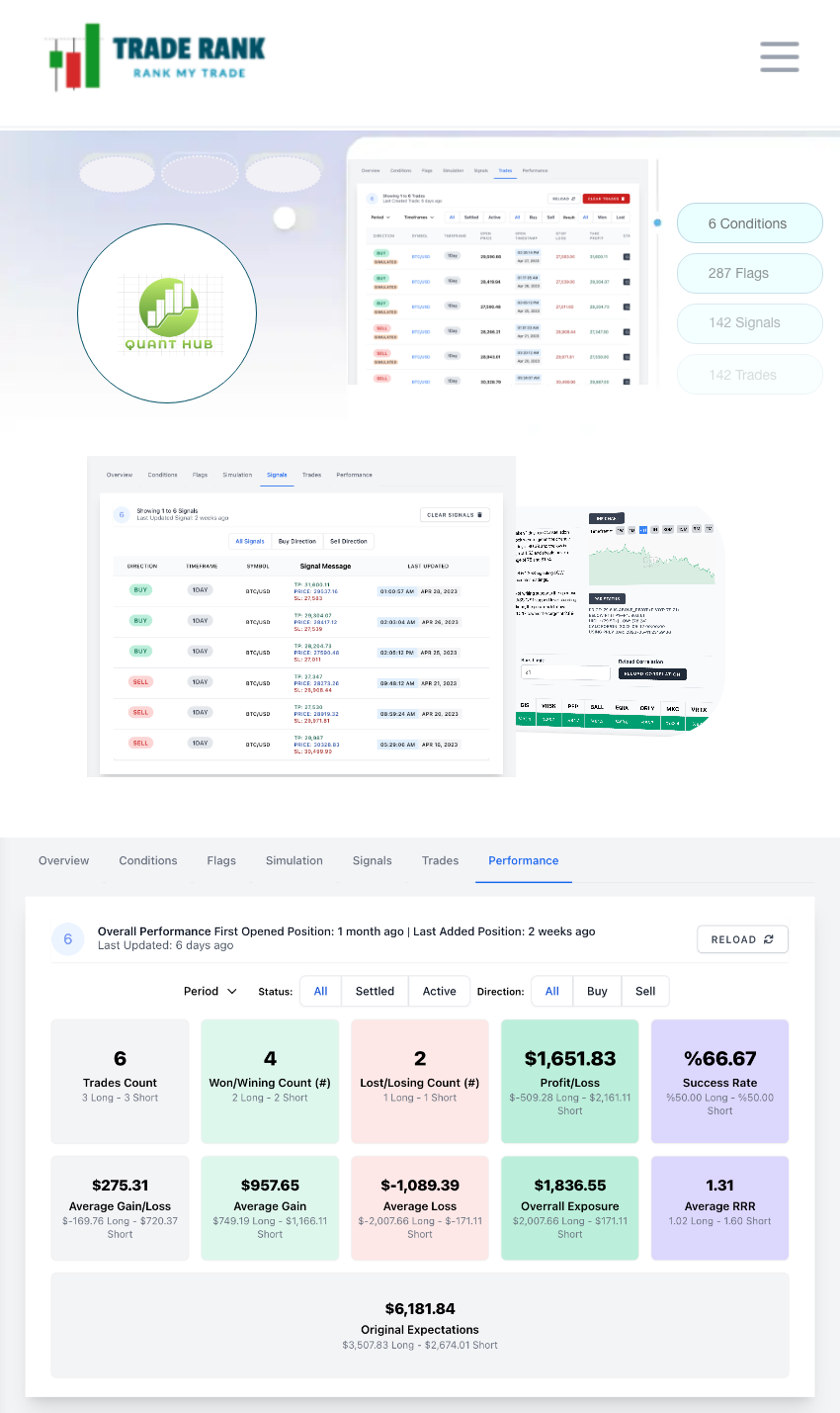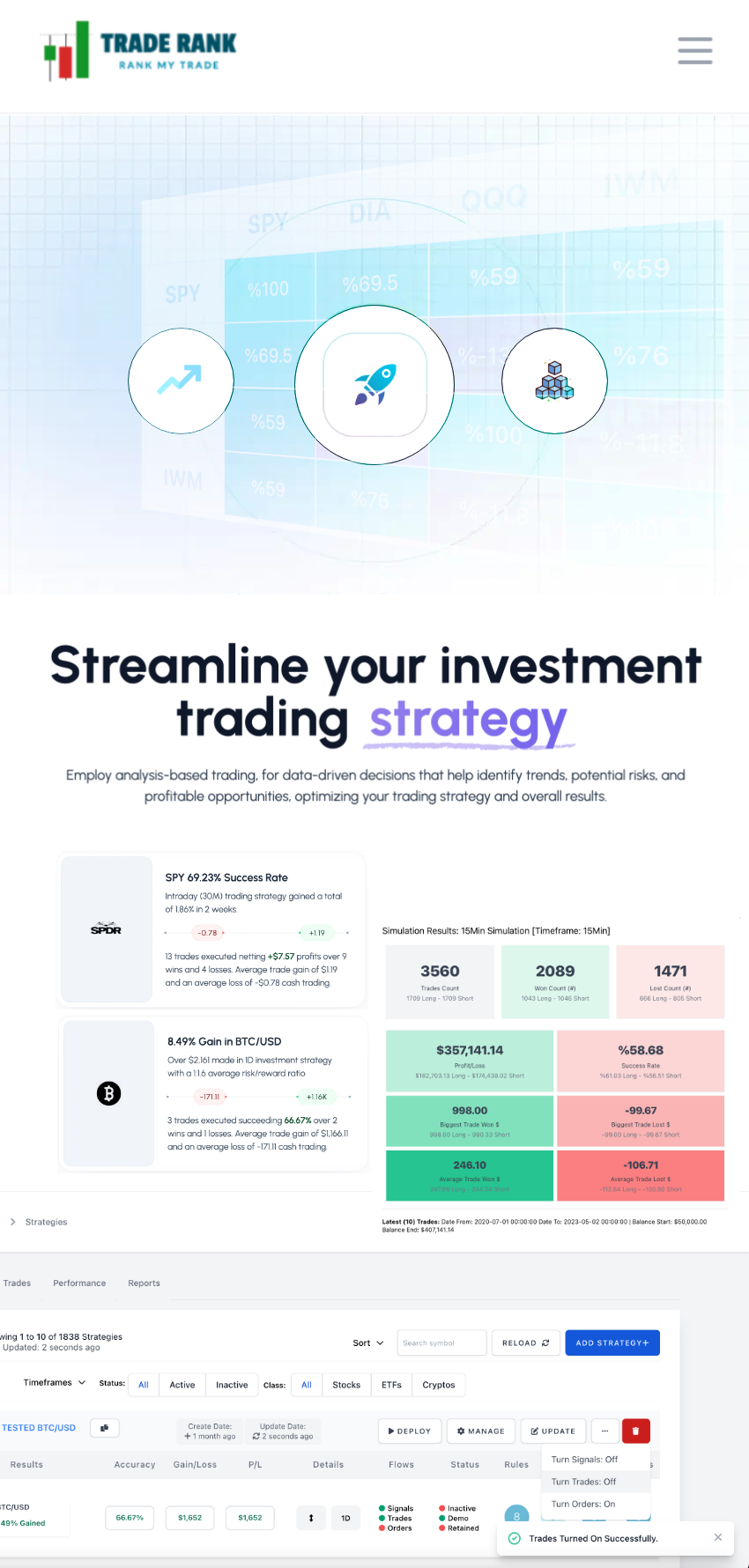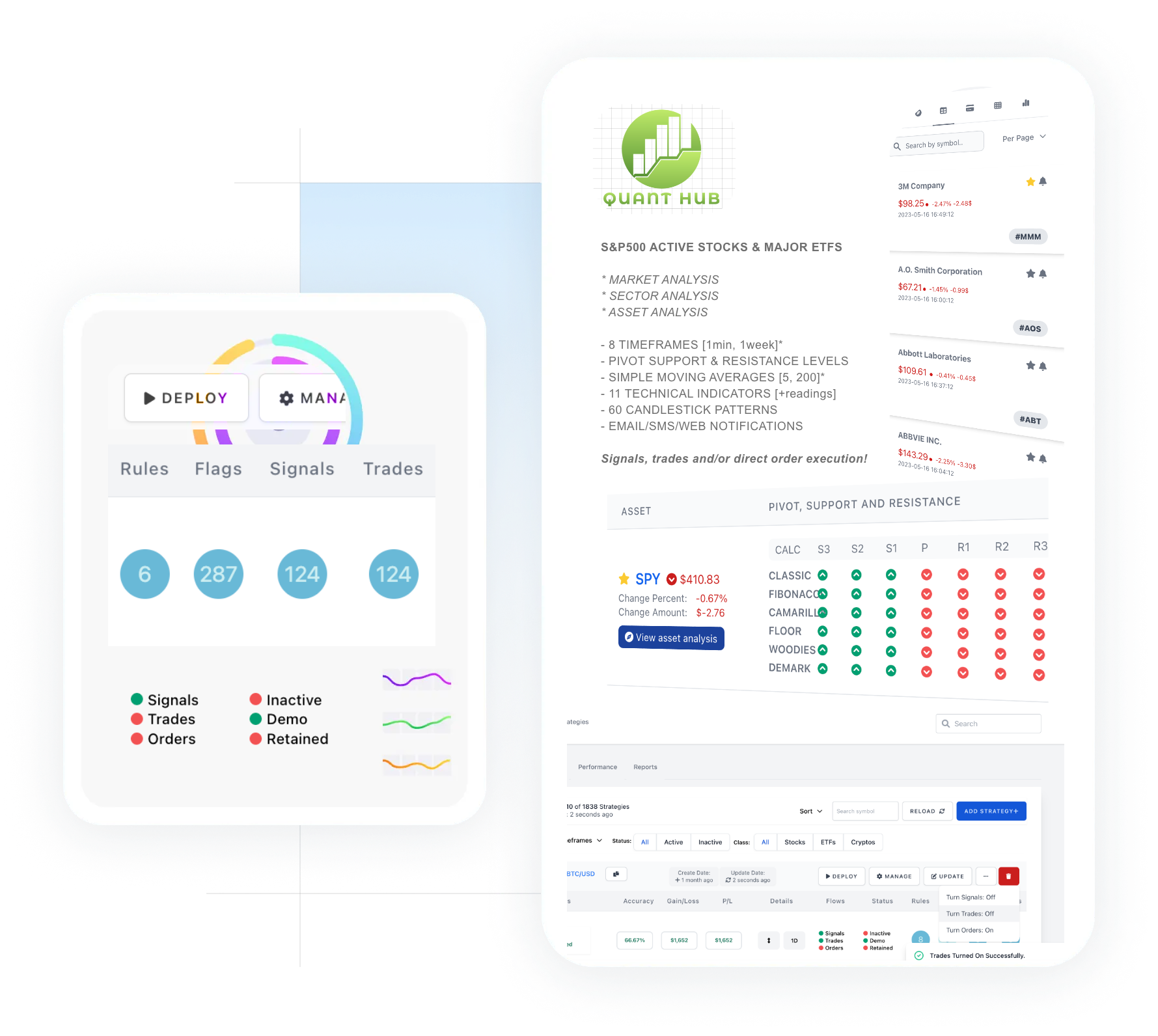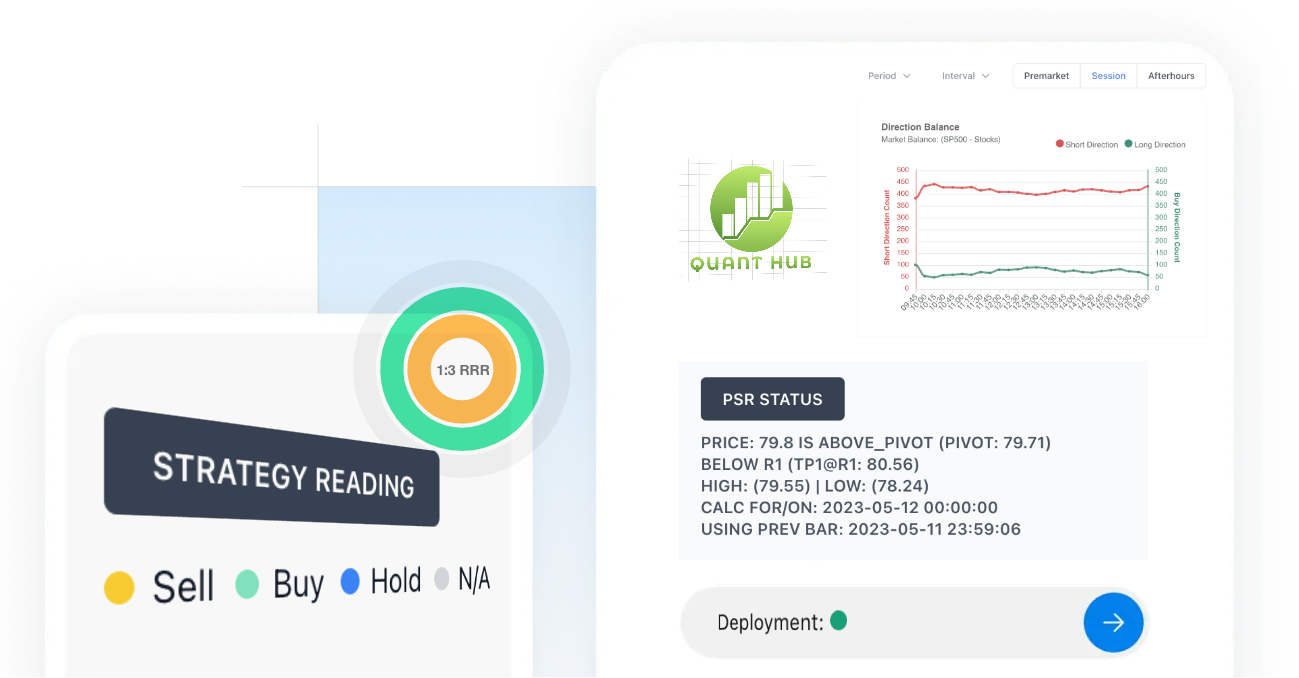Comprehensive Guide to Trading Strategies
Discover a wide range of trading strategies that can be effortlessly automated using our platform.
Moving Average Crossover Strategy
The Moving Average Crossover Strategy leverages the power of two different moving averages to identify potential trends in the market. By waiting for the shorter-term moving average to cross above the longer-term moving average, traders aim to capture emerging uptrends and avoid false signals during periods of consolidation. This strategy is straightforward yet effective in providing clear entry and exit signals based on the changing dynamics of price trends.
Strategy:
Buy when the short-term moving average crosses above the long-term moving average, and sell when it crosses below.
Indicator(s):
50-day and 200-day moving averages.
Information
SMA calculates the average value of a subset of data points within a specified window as it moves through the data.
RSI (Relative Strength Index) Strategy
The RSI Strategy is effective for identifying potential reversal points in the market based on overbought or oversold conditions. By using the RSI indicator with a 14-period setting, traders can pinpoint entry and exit opportunities with greater precision, aligning their trades with the momentum of price movements. This strategy provides a structured approach to trading, leveraging the inherent cyclical nature of market sentiment as reflected by the RSI oscillator.
Strategy:
Buy when RSI crosses above 30 from below (oversold condition) and sell when RSI crosses below 70 from above (overbought condition).
Indicator(s):
RSI with default 14-period setting.
Information
The RSI Strategy identifies overbought and oversold conditions to predict potential reversals in market trends.
Breakout Strategy
The Breakout Strategy is effective in capturing significant price movements as assets break through key support or resistance levels. By carefully monitoring price action and volume, traders can identify potential breakout opportunities and position themselves to capitalize on emerging trends. This strategy relies on the principle that breakout movements often lead to sustained trends, allowing traders to participate in profitable market moves with defined entry and exit points.
Strategy:
Identify price breaking above a significant resistance level (buy signal) or below a support level (sell signal).
Indicator(s):
Support and resistance levels, possibly combined with volume analysis.
Information
The Breakout Strategy aims to capture significant price movements when assets break above resistance or below support levels.
MACD (Moving Average Convergence Divergence) Strategy
The MACD Strategy effectively identifies changes in trend momentum and generates clear buy or sell signals based on MACD line crossovers and divergences. By integrating moving averages with momentum analysis, traders can refine their decision-making process and capitalize on market trends with greater confidence. This strategy provides a structured approach to trading that aligns with the dynamics of trend strength and momentum shifts in the market.
Strategy:
Buy when the MACD line crosses above the signal line and sell when it crosses below.
Indicator(s):
MACD (typically 12,26,9 settings).
Information
The MACD Strategy identifies trend changes and momentum shifts using moving average convergence and divergence.
Bollinger Bands Strategy
The Bollinger Bands Strategy is effective in identifying potential buy and sell signals based on price volatility and market conditions. By monitoring the width of the bands and price movements relative to the bands, traders can anticipate potential breakout opportunities and manage risk effectively. This strategy provides a systematic approach to trading that utilizes technical analysis tools to enhance decision-making and trading outcomes.
Strategy:
Buy when the price touches the lower Bollinger Band and sell when it touches the upper Bollinger Band.
Indicator(s):
Bollinger Bands with standard deviation of 20.
Information
The Bollinger Bands Strategy uses volatility indicators to identify potential entry and exit points.
ADX (Average Directional Index) Trend Strength Strategy
The ADX Trend Strength Strategy is valuable for traders seeking to identify strong trends and potential trend reversals. By using the ADX indicator alongside directional movement lines, traders can gauge the strength of market trends and make informed decisions about entering or exiting positions. This strategy offers a systematic approach to trading that focuses on trend strength, helping traders align with prevailing market dynamics for improved trading outcomes.
Strategy:
Buy when ADX is above 25 and the +DI line crosses above the -DI line, indicating a strengthening uptrend. Sell when ADX falls below 20.
Indicator(s):
ADX with default 14-period setting.
Information
The ADX Strategy evaluates trend strength and potential reversals using directional indicators.
Fibonacci Retracement Strategy
The Fibonacci Retracement Strategy is effective for identifying potential reversal points in a price trend based on the Fibonacci sequence. By using Fibonacci retracement levels, traders can anticipate where price corrections may end and new trends could begin, enhancing their trading decisions with structured levels of support and resistance. This strategy aligns with the principle that markets often exhibit retracement patterns that follow natural ratios, providing clear signals for entry and exit points in trades.
Strategy:
Buy at Fibonacci support levels (e.g., 38.2%, 50%, 61.8%) after an uptrend and sell at Fibonacci resistance levels after a downtrend.
Indicator(s):
Fibonacci retracement levels of price range over a period of time.
Information
The Fibonacci Retracement Strategy identifies potential support and resistance levels using Fibonacci ratios.
Ichimoku Cloud Strategy
The Ichimoku Cloud Strategy offers a comprehensive approach to trading by integrating multiple technical indicators into one chart. By interpreting the cloud's thickness, the position of Tenkan-sen and Kijun-sen lines, and the Chikou Span, traders can identify potential trend reversals, entry points, and exit strategies with greater accuracy. This strategy provides a structured method for analyzing market trends and making informed trading decisions based on clear signals derived from Ichimoku components.
Strategy:
Buy when the price breaks above the cloud (Kumo) and sell when it breaks below.
Indicator(s):
Ichimoku Cloud (includes Kumo, Tenkan-sen, Kijun-sen).
Information
The Ichimoku Cloud Strategy integrates multiple indicators to identify trends and potential reversal points in the market.
Volume Analysis Strategy
The Volume Analysis Strategy enhances trading decisions by incorporating volume dynamics into technical analysis. By interpreting changes in trading volume alongside price movements, traders can validate signals, anticipate potential trend reversals, and manage risk effectively. This strategy provides a practical framework for assessing market sentiment and aligning trades with underlying market activity for improved trading outcomes.
Strategy:
Buy when there is a significant increase in volume accompanying a price increase (indicating strong buying interest). Sell when volume decreases during a price increase (indicating weakening interest).
Indicator(s):
Volume bars with moving average or comparative analysis.
Information
The Volume Analysis Strategy focuses on analyzing trading volume to confirm trends and identify potential reversals.
Momentum Strategy
The Momentum Strategy is effective for identifying and capitalizing on stocks with strong price momentum. By focusing on stocks exhibiting significant price movements and confirming trends with momentum indicators, traders can make informed decisions to enter and exit positions at favorable times. This strategy aligns with the principle of "the trend is your friend," allowing traders to ride momentum trends for potential profits while managing risk through disciplined trading practices.
Strategy:
Buy when the price shows strong upward momentum (e.g., consecutive higher closes) and sell when momentum weakens (e.g., lower highs).
Indicator(s):
Price momentum indicators (MOM) or rate of change (ROC).
Information
The Momentum Strategy focuses on identifying stocks with strong upward or downward momentum to capitalize on continuing trends.
Gap Trading Strategy
The Gap Trading Strategy leverages price gaps as potential indicators of short-term price momentum and market sentiment. By reacting quickly to price gaps and using appropriate risk management techniques, traders can capitalize on volatile price movements driven by market news or events. This strategy requires disciplined execution and the ability to act swiftly based on real-time market conditions to maximize trading opportunities while managing risk effectively.
Strategy:
Buy when the price gaps up at market open and sell when it gaps down.
Indicator(s):
Gap scanner or manual identification of price gaps.
Information
The Gap Trading Strategy involves identifying and trading stocks that exhibit price gaps at market open to capitalize on short-term price movements.
Pattern Recognition Strategy
The Pattern Recognition Strategy relies on technical analysis to identify recurring price patterns that suggest potential market moves. By understanding the psychology behind these patterns and confirming them with volume and other indicators, traders can make informed decisions to enter or exit trades at opportune times. This strategy provides a systematic approach to trading that leverages historical price patterns to forecast future price movements and manage risk effectively in the market.
Strategy:
Buy or sell based on the completion of recognized chart patterns that signal trend reversals or continuations.
Indicator(s):
Chart pattern recognition tools or manual pattern identification.
Information
The Pattern Recognition Strategy involves identifying and trading based on well-known chart patterns that signal potential trend reversals or continuations.
The Moving Average Crossover Strategy is a popular trend-following strategy used by traders to identify changes in momentum and potential entry or exit points in the market. It involves using two moving averages of different time periods and generating signals based on their crossover.

The Relative Strength Index (RSI) Strategy is a momentum oscillator that measures the speed and change of price movements. It helps traders identify overbought or oversold conditions in the market, potentially signaling reversal points.

The Breakout Strategy is designed to capitalize on significant price movements that occur when an asset's price moves above a resistance level (buy signal) or below a support level (sell signal). It aims to catch momentum-driven trades as prices break out of established trading ranges.

The MACD (Moving Average Convergence Divergence) Strategy is a trend-following momentum indicator that helps traders identify changes in the strength, direction, momentum, and duration of a trend in a stock's price.

The Bollinger Bands Strategy utilizes Bollinger Bands, which consist of a middle line (Simple Moving Average) and two outer bands (standard deviations away from the middle line). This strategy helps traders identify potential entry and exit points based on price volatility.

The ADX (Average Directional Index) Trend Strength Strategy helps traders identify the strength of a trend and potential entry or exit points based on the ADX indicator. It measures the strength of the trend regardless of its direction (upward or downward).

The Fibonacci Retracement Strategy is a technical analysis tool used to identify potential support and resistance levels based on the Fibonacci sequence. Traders use Fibonacci retracement levels to anticipate where a price correction or reversal might occur during a trend.

The Ichimoku Cloud Strategy is a comprehensive technical analysis tool used to identify trends, support and resistance levels, and potential reversal points in the market. It provides a holistic view of price action by integrating multiple indicators into a single chart.

The Volume Analysis Strategy focuses on analyzing trading volume to gauge the strength or weakness of price movements. It helps traders confirm trends, identify potential reversals, and assess the validity of breakout or breakdown signals.

The Momentum Strategy focuses on identifying stocks that exhibit strong upward or downward momentum, aiming to capitalize on continuing trends or reversals in price movement.

The Gap Trading Strategy involves identifying and trading stocks that exhibit price gaps at market open, aiming to capitalize on short-term price movements driven by overnight or intraday news, earnings reports, or other significant events.

The Pattern Recognition Strategy involves identifying and trading based on well-known chart patterns that signal potential trend reversals or continuations. Traders use technical analysis to spot these patterns, which can provide clear entry and exit signals.


